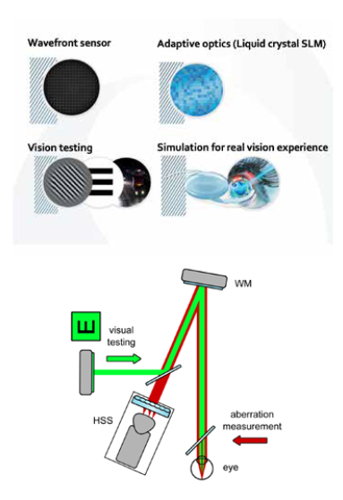Cataract, Refractive
Adaptive Optics
Visual depth of focus is not determined by optics alone

Roibeard O’hEineachain
Published: Monday, July 3, 2023
“ For the same retinal image, two different persons can have different tolerance for aberrations. “
New adaptive optics technology that simultaneously measures subjective vision and optical aberrations shows optics isn’t everything when it comes to visual depth of focus, said Professor Pablo Artal.
“Neural responses are very important, and that is why we need to do psychophysical measurements,” he said. “For the same retinal image, two different persons can have different tolerance for aberrations.”
In the young person’s eye, Prof Artal noted accommodation involves three separate phenomena: defocus of the crystalline lens, eye convergence, and pupil constriction. In the presbyopic patient, there is a loss of defocus, but convergence and pupil constriction persist as before. A very small pupil can preserve depth of focus through the pinhole effect, although it comes at the expense of a reduction in retinal illumination.
He noted the early years of this century saw a drive among both cataract and refractive surgeons to reduce optical aberrations, either through IOL design or wavefront-guided LASIK. However, it became clear a certain amount of spherical aberration could increase depth of focus.
“Again, a trade-off, just as with pupil size, if you add a lot of extra aberration, you increase depth of focus, but in the end, your image quality [will] decrease,” he added.
Measuring and quantifying depth of field
Depth of field can be measured both by optical and visual means. Optical means include devices like the HD Analyzer—a machine based on recording double-pass retinal images—and wavefront aberrometry to record changes in the eye’s aberration as the object in view becomes closer. Visual depth of field measurements can be obtained by moving the object in view further or closer to the eye and recording the threshold at which it is no longer in focus. Both approaches can help chart defocus curves. However, the degree of correspondence between the defocus curves obtained in these two ways can vary considerably between individuals.
As a result, it can be difficult to predict the depth of focus a patient will achieve with a multifocal or extended depth of vision IOL or presbyopic LASIK. Prof Artal said this can be overcome by measuring the optical and visual depth of field using a device he helped develop and has patents for—the VAO adaptive optics visual simulator. The device allows the simultaneous measurement of a patient’s optics under different simulated optical conditions with a wavefront sensor while measuring visual depth of focus. Research Prof Artal has conducted shows simulations of identical amounts of spherical aberration resulted in a highly variable visual depth of focus from patient to patient.
“Adaptive optics visual simulators are an ideal way to provide accurate visual and optics depth of field measurements,” he said. “You have to keep in mind that visual through-focus curves show significant individual variability under identical optical conditions.”
Prof Artal presented his findings at an ESCRS eConnect webinar. For more information, see https://escrs.glueup.com/org/escrs/events/.
Pablo Artal PhD is a professor of optics at the Laboratorio de Óptica, Universidad de Murcia, Murcia, Spain. pablo@um.es

Latest Articles
Beyond the Numbers
Empowering patient participation fosters continuous innovation in cataract surgery.
Thinking Beyond the Surgery Room
Practice management workshop focuses on financial operations and AI business applications.
Aid Cuts Threaten Global Eye Care Progress
USAID closure leads retreat in development assistance.
Supplement: ESCRS Clinical Trends Series: Presbyopia
Nutrition and the Eye: A Recipe for Success
A look at the evidence for tasty ways of lowering risks and improving ocular health.
New Award to Encourage Research into Sustainable Practices
Sharing a Vision for the Future
ESCRS leaders update Trieste conference on ESCRS initiatives.
Extending Depth of Satisfaction
The ESCRS Eye Journal Club discuss a new study reviewing the causes and management of dissatisfaction after implantation of an EDOF IOL.
Conventional Versus Laser-Assisted Cataract Surgery
Evidence favours conventional technique in most cases.
AI Scribing and Telephone Management
Automating note-taking and call centres could boost practice efficiency.